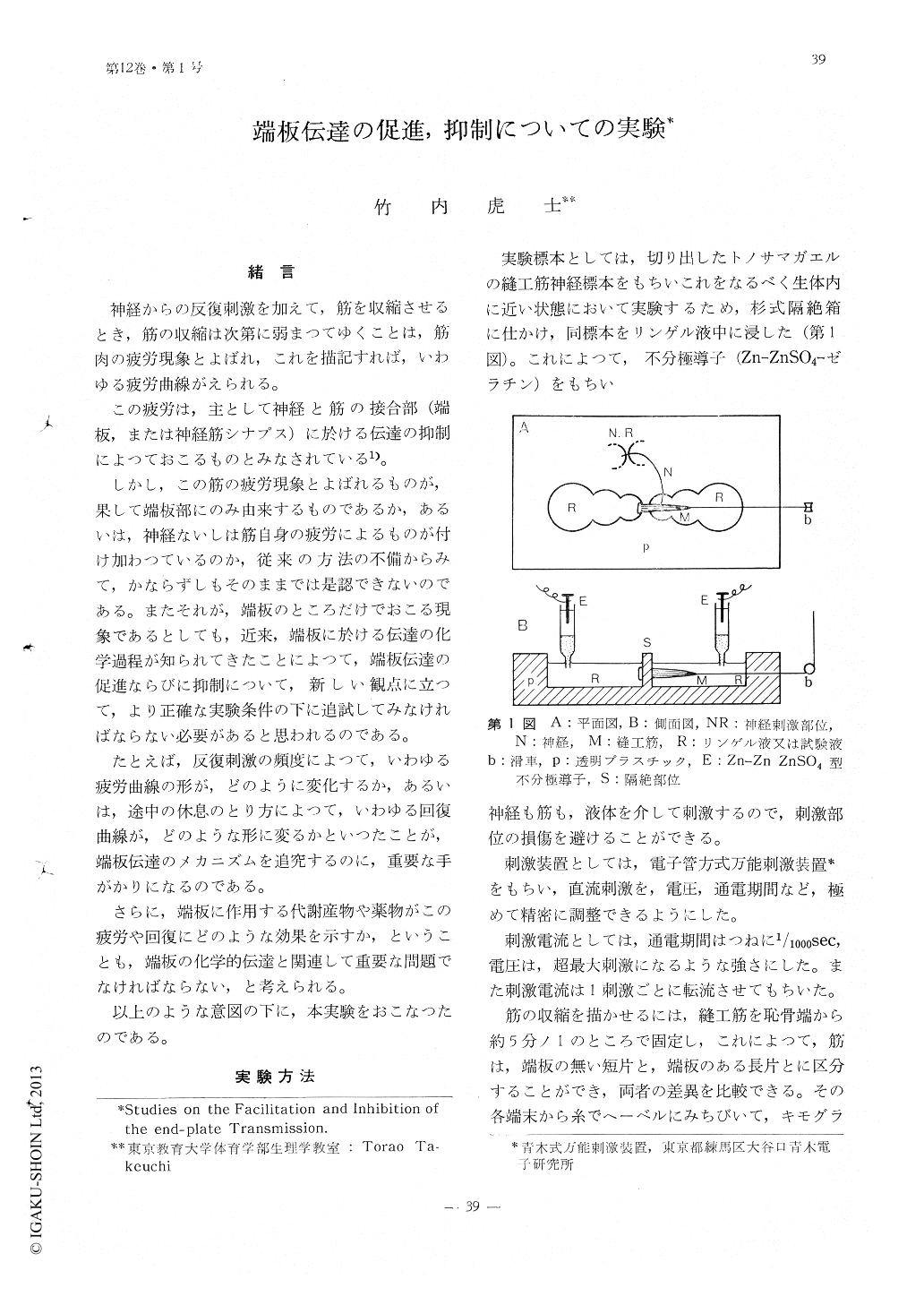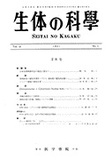Japanese
English
- 有料閲覧
- Abstract 文献概要
- 1ページ目 Look Inside
厳密な条件の下に神経から端板を介して筋に反復刺激を加え,いわゆる疲労曲線を描せて,疲労ならびに回復過程を追求し,これは端板伝達における促進あるいは抑制によるものであることを確めた。実験成績は次のごとく要約される。
① 反復刺激の頻度ならびに休息の挿入を変えることによつて,それぞれ一定の型の疲労回復の曲線がえられる。
② この疲労と回復の過程は主として端板部における代謝産物の集積と離散とのバランスによるものと推定される。
③ そこで端板物質であるAchならびに筋収縮により生産される乳酸を端板に作用させてみたところAchでは10−8%(10−10)乳酸では0.006%(6×10−5)のところに臨界濃度があり,これより高濃度では抑制され,低濃度では促進される。
④ したがつてこの疲労と回復の効果は端板におよぼすAch,乳酸などの代謝産物の活用が重要な役割をもつと考えられる。
⑤ 端板毒Curareも,Ach,乳酸と同様の効果があり,10−6%以下の低濃度では促進的に作用するものでいわゆるCurareの端板抑制効果は10−6%濃度以上でのみ,みられる。
⑥ 同様なことはEthylalcohol及びAcetaldehydeによつて見られ,臨界濃度はEthyl-alcoholでは大体0.15% Acetaldehydeでは0.008%であつた。
⑦ 神経遮断剤Banthineはもつぱら抑制的(遮断的)作用のみで,促進作用は認められなかつた。Curareの如き端板毒とは作用機構が異るものである。
以上の成績から,いわゆる筋の疲労曲線は主として端板部における伝達の疲労と回復に由来するもので,端板伝達の促進抑制がその重要な役割を果たすものであり,またこの端板効果は神経筋の代謝産物の濃度によつて大きく影響されると云うことが出来る。
Using a nerve muscle preparation (m. sartorius of a frog), the courses of muscular fatigue and recovery, so-called, "Ermüdungskurve of muscle", were investigated. The muscle placed in Sugi's "Insulation chamber" soaked with various test solutions was stimulated both directly or indirectly by means of a specially devised electronic stimulator.Experimental results are summarized as follows:
1. By changing the stimulation (the frequency and duration of a series repetitive stimuli) and also by changing the duration of intervals (pause of stimulation), the development of fatigue as well as recovery in the "Ermüdungskurve" showed a characteristic type in each condition.
2. According to the difference of the type of "Ermüdungskurve" in various conditions, it is suggested that so-called fatigue or recovery of muscular contraction is caused mainly by the facilitation or inhibition of the transmission at the end-plate region.
3. The effect of acetylcholine (Ach) known as chemical transmitter, or lactic acid produced by muscular activity, on the end plate was tested, and the critical concentration of Ach and lactic acid were found to be 10-8% and 0.006% respectively. Namely. in both cases, neuromuscular facilitation was observed the concentration lower than the critical value, while the inhibition occurred at the higher concentration.
4. From the abovementioned results, it is supposed that the metabolic products, such as Ach and lactic acid, play an important role in the mechanism of the end-plate transmission, and it may be assumed that the facilitation or the inhibition of end-plate transmission is merely due to the difference of concentration of the same metabolite. And the appearance of various types of "Ermüdungskurve"is regarded to be based on the balanc between the accumulation and dispersion of the metabolites accompanying both muscular and neuromuscular activities.
5. Curare, an end-plate poison, has the same effect as Ach and lactic acid: i.e., curare causes the facilitation of end-plate transmission at the concentration lower than 10-6%. The inhibitory effect of curare on the end-plate, is only observed at the concentration higher than 10-6%.
6. The other end-plate poisons, such as ethylalcohol and acetaldehyde, have the same effects on the end-plate: the critical concentration being 0.15%, 0.008% respectively.
7.On the other hand, banthine, ablocking drug of sympathetic nerve, shows only inhibitory effect on the end-plate indicating that its effect is different from the other substances mentioned above.
From above-mentioned results, it may be concluded that so-called "Ermüdungskurve" of muscle is mainly due to the fatigue or recovery of the end plate function, i.e., the inhibition or facilitation of end-plate transmission plays an important role in the "Ermüdungs-kurve".
And it is also concluded reasonably, the end-plate mechanism is largely affected by the concentration of neuromusculrr metabolites.

Copyright © 1961, THE ICHIRO KANEHARA FOUNDATION. All rights reserved.


